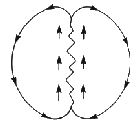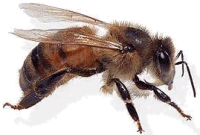HONEYBEE COMMUNICATION
Bees are adept at association learning. A bee will visit a variety of flowers in the morning and, if there is sufficient attraction and reward in a particular type of flower, she will make visits to that variety for most of the day until the plants stop producing pollen or nectar or weather conditions change.

Bees are also able to communicate news of pollen or nectar supply to other bees. A bee returning from an area with many flowers producing an abundant supply of nectar performs a dance on the comb. The orientation of her movements and the frequency of her vibrations indicate the direction and distance of the flowers from the hive. Thus other bees, observing the dance, will know where to find the source of food.

The round dance is performed to indicate forage within a 25 metre radius. For longer distances the "waggle dance" is performed to indicate the distance, direction and quality of nectar.
The waggle dance performed by a "scout" bee shows the location and distance of a nectar supply. The bees then depart on an orientation flight aided by the sun for navigation, then fly back and forth direct after locating the source.
